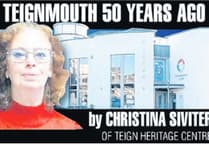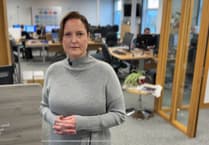IT was joyful to have this letter last Thursday from a grandmother whose little grandchild I had operated on about 35 years ago, writes retired consultant, Doctor David Halpin.
That Sue and I were celebrating our 62nd wedding anniversary on the Saturday added to the joy, and reminded us of how fortunate we were to be part of healing.
“
'Dear Dr Halpin,
Your article recently has mentioned something that seems to be in short supply these days - it refers to “common sense.”
It prompted me to search through some papers and I am sending a copy of an obituary to common sense which I found many years ago.
You may already be aware of it, but it is so true.I would also like to say my family owes you a great debt of gratitude. Some 30 plus years ago my granddaughter was learning to walk and had a very definite limp.
We were fortunate our G.P was Dr Clayton-Payne. Who referred her to you. X-rays show she did not have a compete hip socket on her right side.
You did a bone graft, but we were warned she might not be able to dance. Well not only did she dance but took up running marathons.
At a time when so many people are going privately for medical help, I think back to the 1980s’ and the skill and care she received.
There is no way the family could’ve afforded to pay for the operation. Where did it all go wrong? I hope you will be able to continue your news in the MDA, I do look forward to them.
-
And I agree that common sense has taken a battering but there are many out there who have it but are quiet and patient. I will return to this ‘obituary’ at the end.
You are unlikely to know the origin of the word ‘orthopaedic’. Many connect it to feet, but its essence is the ‘straight child’.
A common symbol of orthopaedic associations is the Tree of Andry. He was a French physician who wrote of deformity and on the front cover of his treatise was this picture of a straight stake with a twisted sapling bound to it.
This emphasises that our job as orthopaedic surgeons was to correct deformities such as club foot, dislocation of the hip from birth, scoliosis - twisting of the spine etc.
But most people now associate our specialism with ‘joint replacement’ in older people, and this is indeed what most such surgeons are involved with, as well as looking after folk with skeletal trauma.
After six years in other fields of surgery, I spent five years training in orthopaedic and trauma surgery - mostly at the Princess Elizabeth Orthopaedic Hospital, Exeter.
This training involved the care of children with broken bones and the care of babies and little ones, say with dislocation of the hip - be it total or partial - ‘sloppy’.
When I became a consultant (I prefer ‘specialist’) in 1975, it fell upon me to look after children with these conditions that were there at birth, and this involved about a quarter of my time.
Some of that was spent checking babies whose hips after that proper examination soon after birth were thought to have hip joints which were dislocated (CDH), or could be dislocated gently.
I easily recall, and used to speak of it in teaching, that when I was driving up from Combe-in-Teignhead to my Thursday operating list at the PEOH and there was an infant with a CDH, I felt the tension. The fact - I was doing my best to set that hip right with a good 80 years of life ahead.
This happy outcome depended partly on my skill and commitment. But there was much more.Firstly it was taking place in what is called a ‘stand alone’ specialist hospital that came alive in 1926 and which could do steady, planned surgery without the ever present inward flow of emergencies - especially in the medical field.
Secondly, the whole of the excellent staff at the PEOH knew their jobs and proudly wanted to do their very best for all who came into their care.The anaesthesia of the infant is specialist too, and I think back to Dr Peter Butler and then Dr Gordon Wray. What operation did this little girl have? It was called the Salter osteotomy - bone cutting literally.
This was after Professor ‘Bob’ Salter from Toronto. The operation he described was well established, and as with many other leaders in the field he came to us at the PEOH to speak of the operation and to give his opinion on patients with problems which we presented to him.The operation involved cutting across the pelvis just above the hip joint, tilting it down to cover the head of the femur better, and holding it there with a wedge of bone.
The capsule was cut as a letter T andthen sewn up to keep the head of the femur nicely ‘in joint’. Then a plaster of Paris hip ‘spica’ was applied to ensure the new position was held secure.The hospital, on a ground floor with gardens around going back to Veitch whose house was there with 80 acres of nursery surrounding, had all the right facilities.
The occasional bed bound patient could be wheeled out into the fresh air and sun, just as in former days when tuberculosis was rife.There were 120 beds - four adult wards and a children’s ward lead by Sister Latimer. Some children had to stay for long so there was an excellent teacher; they did not lose out.
There was a large and fine hydrotherapy pool, so valuable for those with advanced arthritis, and a large gymnasium.A modern out-patient block had been added with generous corridors and cubicles so that patients having day surgery could be wheeled to theatre. The PEOH pioneered day surgery.
We surgeons had pushed for expansion of the hospital because we knew very well that the demand for our surgery was growing with ageing of the population and ever advancing capabilities.In about 1986 a complete re-engineering of the hospital was completed; re-wired, re-plumbed and with a new boiler house with a 40 meter chimney!
Four new theatres had replaced two pre-WW2 ones. I was quietly proposing that OUR NHS should build an addition where men and women of working age who had suffered acute illness or injury, and who had been off work for six weeks or more, could be referred immediately for diagnosis and assessment.
Any necessary surgery would be made available in the unit quick sticks in the hospital along side. But I was not good at lobbying, always believing that a good idea should promote itself.I return to the letter from that little girl’s Gran. ‘Where did it all go wrong?
’I will tell you next week after Sue and I have had a three day break in the ‘Isle of Purbeck’ where we met in hare bell time - in 1959.But meanwhile read on the home page of <dhalpin.infoaction.org.uk/? - bottom right “A Quotation From: The NHS Dismantled” and the full review linked below.=Add that for those affording computers - text of ‘Obituary to Common Sense’ - <https://rcoa.org.au/PDFs/Common_Sense.pdf>



Comments
This article has no comments yet. Be the first to leave a comment.